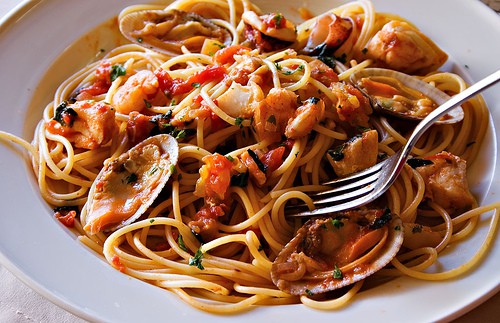Italian Cuisine and its History

Italy, a country so culturally different from region to region, is full of people and culinary art that make it as vivid and interesting as an intricately woven and colorful tapestry.
Despite the export of Italian cuisine, REAL Italian fare offers a delectable explosion of tastes, color and variety. In fact, the idea of a conventionally unified Italian cuisine brings horror to the face of every Italian chef in the country, whether he/she be a professional or simply favor the art of Italian cooking.
Italy boasts of distinct regional dishes with tastes that are as different as night from day, even though these delicacies may have the same name. Even the basics will change from one region to another. “Do you want your pasta with an egg?” asks a waiter in one region, whereas in another, the waiter would never dream of offering egg with pasta.
Some regions use butter in abundance, where others consider such a thing blasphemy and prefer to use olive oil. It is the food that gives visitors insight into the region’s history and landscape.
Italian Cuisine History
Despite its small size, about half the size of Texas, Italy has twenty regions, each with distinct cultural differences. Every village and town may make a dish with the same name, but the cooking process is vastly different. Cooking traditions define the people of the country just as much as their dialects, their traditions and their customs. These customs are shaped by the geographic and historical differences of each village with some being landlocked and mountainous and others being surrounded by the milder climate of the sea. Some regions have integrated with Greek and Arab influences, while others experience French and Austrian guidance.
The country boasts of a rich and interesting history. It dates back to the fall of the Roman Empire in 476. After which it was made up of independent city states and only unified recently in 1861. Before the unification these independent republics and regions spent much of their time fighting neighbors and intruders. One could even say that the exchange of culinary traditions is only a recent event, as most regions were isolated due to geographic location, a lack of roads and technology.
Cooks the world over visit the different regions of Italy to learn the traditional recipes of each region. Often they find that a dish loved in one region is often unheard of just a few miles away. Visiting cooks quickly realize that there is no such thing as ONE Italian Cuisine, but instead it is made up of distinct cuisines with its own flavors and preferred cooking methods.
General Regional Italian Cuisine Tendencies
Despite the differences from town to town there are some basic general tendencies. For instance, northern Italians tend to consume more rice and polenta dishes than Italians in the south. And southern Italian cooking is defined by its use of olive oil instead of butter. But there are even more intricate place-specific dishes that make the cuisine so fascinating. For example, some dishes like are only prepared in a certain city.
Conclusion
People who have experienced the beauty of Italy agree that the richness of the cuisine lies in its diverse nature. Regional food and cooking styles vary greatly across the country, with each recipe having a long history, some being prepared for thousands of years.

